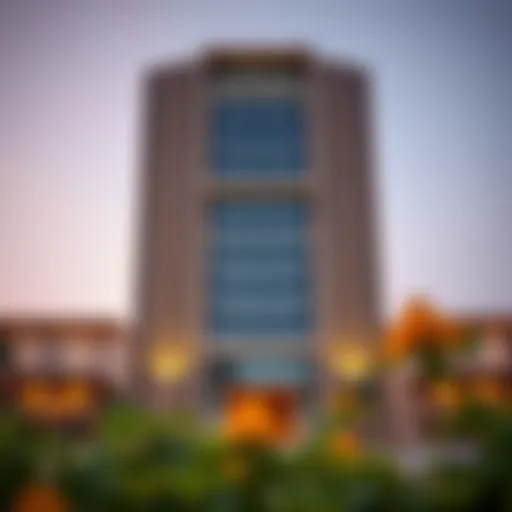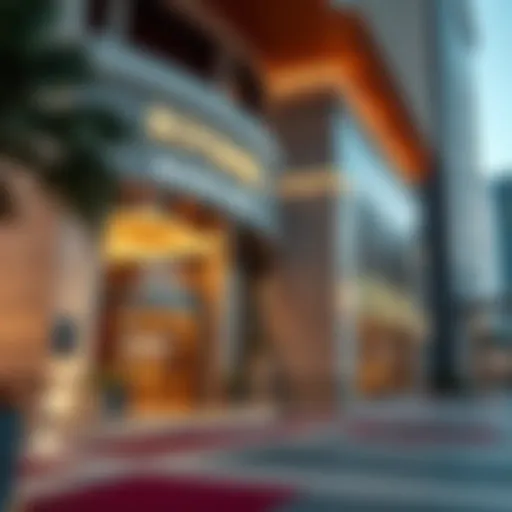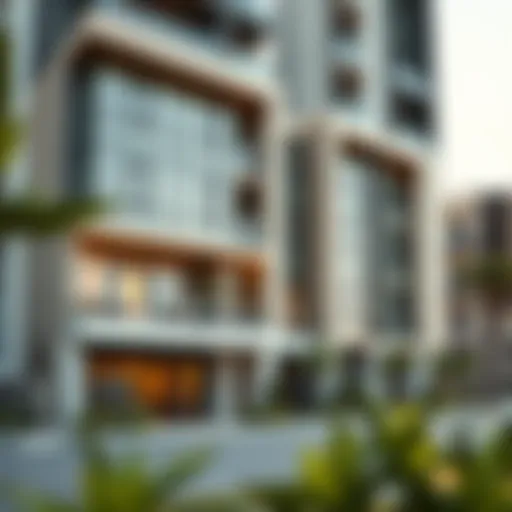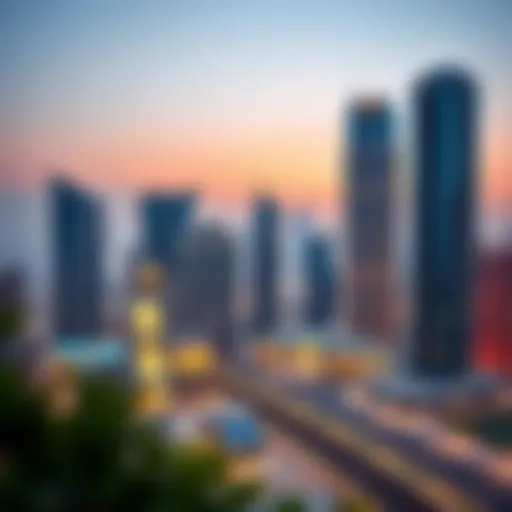Exploring the Significance of Burj Khalifa in Dubai


Intro
Burj Khalifa, not just a towering skyscraper but a statement of ambition, stands tall in the heart of Dubai. Completed in 2010, it stretches a remarkable 828 meters into the sky, leaving many in awe of its grandeur and engineering brilliance. This article aims to dissect the many facets of this architectural marvel—how it embodies the aspirations of a city eager to lift itself on the world stage. Throughout, we will touch on significant themes that underline Burj Khalifa's influence, not only as a physical structure but also in shaping the real estate landscape of Dubai.
Understanding the context around Burj Khalifa can be crucial for investors, homebuyers, agents, and analysts. From market trends to investment opportunities, the accompanying insights can foster a deeper appreciation of how such developments are intertwined with economic variables and urban planning. Let's kick off this exploration by diving into the current market trends surrounding this iconic building.
Market Trends
Current Property Trends in Dubai
The real estate market in Dubai has been a veritable rollercoaster over the past decade, especially following the global financial crisis. However, since around 2020, a tangible recovery has taken shape. The Burj Khalifa region, particularly downtown Dubai, has seen an uptick in property prices, driven by a mix of investor interest and a surge in tourism. Notably, the blending of luxury living with high-end amenities has attracted both local and international buyers.
- Luxury Demand: Properties around Burj Khalifa cater mainly to affluent clientele, with luxury apartments and office spaces becoming increasingly sought after.
- Cultural Tourism: Not only is Burj Khalifa a tourist attraction, but it also acts as a catalyst for local business and hospitality, further propelling the demand in nearby residential areas.
This uptick paints a promising picture, yet it's essential to remain aware of market fluctuations and the factors driving them—the upcoming World Expo events, ongoing urban developments, and evolving lifestyle choices of residents all play roles in shaping these trends.
Future Projections for Dubai Real Estate
Looking ahead, analysts predict that the Dubai property market will continue to thrive, especially in sectors aligned with innovation and sustainability—two pillars of the Emirati vision for the future. Burj Khalifa serves as a benchmark, underscoring what can be achieved with visionary planning.
- Green Initiatives: Buildings with sustainable designs and energy-efficient systems are expected to attract more attention. Projects modeled after Burj Khalifa's architectural integrity and eco-consciousness could take precedence.
- Technological Integration: Smart home features and integrated technology in properties will likely gain popularity, as consumers start yearning for more convenience and comfort.
The growth potential surrounding Burj Khalifa and its neighboring areas indicates a nourishing environment for real estate investments.
Investment Opportunities
Analyzing High-Growth Areas
Investors looking to dip their toes into the Dubai market would do well to consider areas surrounding Burj Khalifa. Neighborhoods such as Downtown Dubai and the recently developed Dubai Creek Harbour are ripe for exploration. The density of high-rises and proximity to pivotal commercial zones boost their attractiveness and investment viability.
- Rental Potential: Given the influx of expatriates and tourists, there’s a consistent demand for rental properties, especially in districts featuring iconic landmarks.
- Commercial Developments: Proximity to Burj Khalifa makes these areas prime spots for businesses aiming to attract clients seeking luxury or novelty.
Understanding Rental Yields and ROI
Real estate investments should ideally focus on the rental yield and return on investment. In the vicinity of Burj Khalifa, the rental yields can range significantly based on the property type. High-end apartments often yield more but come with steeper entry costs. It's a balancing act for investors keen on maximizing their ROI.
- Yields for Luxury Rentals: Investors can expect a range of yields between 4-8%, although high-demand properties can soar above these figures.
- Short-term Rentals: Given Burj Khalifa's touristic allure, short-term rental opportunities might present higher returns, especially during peak tourist seasons.
In summary, understanding these dynamics—current trends, future projections, high-growth areas, and rental yields—creates a roadmap for investing wisely in a market that is both vibrant and evolving, much like the Burj Khalifa itself.
"The Burj Khalifa is not just about height; it’s about reaching new heights in urban development and property investments."
As we transition to detailing the architectural significance of the Burj Khalifa next, it’s almost necessary to appreciate how the foundational concepts of urban real estate and structural innovation merge to create something truly extraordinary.
Prologue to Burj Khalifa
The Burj Khalifa, towering high at 828 meters, is not merely the tallest building in the world; it represents a significant chapter in the architectural narrative of the 21st century. As a focal point in Dubai's skyline, this structure embodies the aspirations and ambitious ethos of the city. The importance of this exploration lies in understanding how the Burj Khalifa has become a crucial player in various spheres—be it tourism, real estate, or even cultural identity.
When investors and real estate enthusiasts turn their gaze to Dubai, the Burj Khalifa often serves as a primary reference point. Its presence has catalyzed substantial urban growth and economic transformation in the surrounding areas, making it a topic worth deep diving into.
Additionally, this section will not just skim the surface of its physical stature but instead highlight its architectural significance, historical context, and the vibrant life surrounding it. Within these discussions, key insights can be gleaned that illuminate broader trends in the real estate market and urban development.
Overview of the Structure
Crafted by the design firm Skidmore, Owings & Merrill, the Burj Khalifa's design is an intricate tapestry of art and science. The architectural concept is rooted in Islamic geometric patterns, evident in its spiraling, three-lobed footprint that rises to a delicate needle. With its glass-and-steel façade, the structure captures the shimmering sunlight during the day and emits a radiant glow after sunset.
Technologically, the Burj Khalifa stands out not just for its height but the innovations used in its construction and materials. To put it bluntly, the Burj is the ultimate engineering feat, designed to withstand the forces of nature with characteristics that keep it stable in high winds and heat.
Historical Context
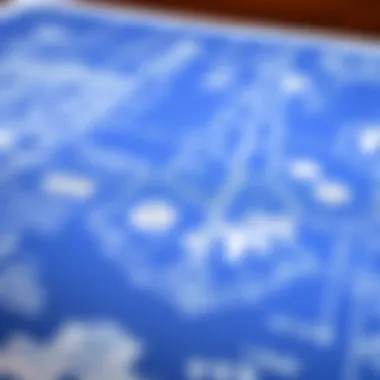

Burj Khalifa's story is woven into the fabric of a rapidly evolving Dubai, where aspirations often bear the weight of monumental dreams. Commissioned during a period of economic boom in the late 2000s, the construction began in 2004 and completed in 2010, amidst the backdrop of the global financial crisis. Ironically, a building rising during turbulent times serves as a potent symbol of resilience.
Originally named Burj Dubai, it was renamed Khalifa in honor of Sheikh Khalifa bin Zayed Al Nahyan, the President of the UAE. This rebranding reflects the interconnectedness of the Emirates, highlighting not merely competition but cooperation amid challenges. The Burj Khalifa has played a crucial role in re-establishing the UAE's economic standing on a global scale.
In essence, understanding the Burj Khalifa is to grasp the essence of modern Dubai itself—a blend of ambition, innovation, and cultural richness that encapsulates the spirit of a city on the rise.
"With great structure comes great responsibility to innovate further and preserve the environment, a mantra Dubai takes to heart."
For those interested in the historical impact of such a landmark, it is essential to analyze how the Burj Khalifa continues to influence both the economic and cultural fabric of not just Dubai, but also the broader region. By doing so, we gather important insights that can inform future investments, architectural endeavors, and urban planning initiatives.
Architectural Features of Burj Khalifa
The Burj Khalifa is not merely a building; it stands as a testament to human ambition and ingenuity. Its architectural features intertwine functionality with aesthetic appeal, making it a focal point of interest for investors, homebuyers, agents, and analysts alike. Understanding these features is crucial for appreciating not just the structure itself but also the implications it holds for the real estate landscape in Dubai.
Design Inspiration
The design of Burj Khalifa draws heavily from Islamic architecture, featuring intricate patterns and shapes that resonate with the local culture. The tower's shape resembles a desert flower, with the base widening and tapering as it ascends, allowing it to harmonize with the surrounding environment. This design is strategic, not only for aesthetics but also for structural integrity, enabling the building to withstand the harsh desert winds.
Incorporating natural elements, the outlines and curves pay homage to nearby structures like the Al Hamra Tower in Kuwait and the Willis Tower in Chicago, yet it stands uniquely and distinctly tall. Designers Adrian Smith and his team from Skidmore, Owings & Merrill emphasized verticality, using setbacks to create a dynamic profile that captivates viewers from all sides.
Materials and Construction Techniques
When it comes to the Burj Khalifa's construction, the materials used are just as innovative as its design. The core structure consists of reinforced concrete, known for its strength and durability, but it's the exterior that truly dazzles. With over 103,000 square meters of glass cladding, the building shimmers under the bright Arabian sun, contributing to both thermal insulation and energy efficiency.
The construction technique employed also showcases ingenuity. Using a method known as the "high-performance concrete mix," the builders managed to reach unprecedented heights without compromising safety. This mix allows the building to endure the extreme pressures experienced at such altitudes, ensuring long-term stability.
The process of erecting such a structure required precision. A unique tower crane system was developed specifically for the Burj Khalifa, allowing cranes to climb with the building as it rose. This innovation exemplifies the forward-thinking methods that characterized the construction process and are essential for high-rise construction.
Key Structural Innovations
One cannot discuss the Burj Khalifa without acknowledging its structural innovations. The building has implemented several groundbreaking technologies to achieve its impressive height and stability. For instance, the bundled tube design reduces wind forces acting on the building, making it a phenomenon in architectural engineering.
The Burj Khalifa also features state-of-the-art damping systems, designed to minimize swaying during strong winds. This level of creativity in structural design not only enhances user comfort but also emphasizes a commitment to safety and resilience.
Moreover, the use of a reflective sky-lobby concept helps to integrate both practical space use and stunning views into the experience of visitors and residents alike. Each design choice resonates with the overarching objective of creating a space that is not just tall but functional and enjoyable.
"The Burj Khalifa represents not only the pinnacle of engineering achievement but also a vision of what urban life can be."
- Unknown
In summary, the architectural features of Burj Khalifa offer profound insight into the melding of culture, innovation, and practicality. For those navigating Dubai’s real estate market, understanding these features is paramount in anticipating the associated opportunities and challenges.
Economic Impact of Burj Khalifa
The Burj Khalifa is more than just the tallest building in the world; it's a cornerstone in the economic fabric of Dubai. The soaring structure not only showcases architectural prowess but also serves as a catalyst for economic growth in diverse sectors. Understanding its economic implications is essential for investors, homebuyers, agents, and analysts who look closely at Dubai’s real estate dynamics and future opportunities.
Real Estate Development
Since its completion in 2010, the Burj Khalifa has acted like a magnet for real estate developments in its vicinity. New residential projects and commercial spaces continue to crop up around this iconic landmark. Developers are drawn to the prestige associated with proximity to the Burj.
- Luxury Residential Projects: High-end condominiums and villas have flourished, transforming the landscape of downtown Dubai. Properties like The Residences at Burj Khalifa offer breathtaking views and exclusive services, appealing to affluent homebuyers.
- Commercial Growth: The influx of businesses into the area around the Burj has led to a surge in commercial properties. Companies often seek office spaces that not only provide a functional environment but also an address that carries weight.
To sum it up, Burj Khalifa functions as a linchpin in propelling the real estate market, elevating property values and paving the way for newer, upscale developments.
Tourism and Visitor Statistics
The Burj Khalifa attracts millions each year, serving as an epicenter for tourists drawn by its gargantuan stature and spectacular views. Analyzing the statistics reveals its far-reaching impact on the tourism sector.
- Visitor Engagement: In its first year alone, the Burj Khalifa drew over 1.8 million visitors to its observation decks. Each year, these numbers have continued to rise, with estimates showing that the tower hosted over 2.8 million visitors in recent years.
- Attracting Tourists: A substantial number of tourists visiting Dubai earmark a trip to the Burj as a must-do activity. The economic churn generated from these visits includes spending on entry tickets, shopping, and dining, benefitting not just the building but the entire region.
"The Burj Khalifa is not just a building; it's a symbol of Dubai's flourishing tourism industry."
As the flow of visitors continues to swell, it plays a role in creating jobs and boosting local businesses, further intertwining with the broader economic landscape of the city.


Business Opportunities Created
In the wake of the Burj Khalifa's construction, a plethora of business opportunities flourished, creating a ripple effect throughout Dubai. From hospitality to retail, the economic spillover is evident.
- Hospitality Sector: Nearby hotels, like the Armani Hotel, have benefited significantly. They capitalize on the influx of tourists eager to enjoy proximity to the Burj and its prestigious status.
- Retail Market: The Dubai Mall, strategically placed next to the tower, has become one of the largest shopping centers globally, attracting both locals and tourists. This has spurred various retailers to open shops within its expansive complex, generating revenue and jobs.
As different businesses thrive in the shadow of the Burj Khalifa, the structure not only redefines the skyline but also reshapes the economic landscape for a diverse array of stakeholders in Dubai.
Burj Khalifa in the Context of Dubai's Real Estate Market
The Burj Khalifa is more than simply a stunning skyscraper; it is a cornerstone of Dubai's evolving real estate market. Its towering presence has shaped not just the skyline but also the dynamic landscape of property development and investment strategies in the region. An analysis of this iconic structure reveals its integral role in bolstering real estate values, driving tourism, and fostering a hub of economic activity. Understanding its impact gives potential investors, homebuyers, agents, and analysts a clearer vision of how strategic planning and architectural marvel can interlace to create economic growth.
Neighborhood Analysis
The neighborhood surrounding Burj Khalifa, often referred to as Downtown Dubai, is emblematic of modern living in a lavish and cultural setting. Here, luxury is not merely an attribute; it is the expectation. The area features several high-end residential complexes, retail outlets, and cultural landmarks.
Some key aspects of the neighborhood include:
- Properties like The Address Downtown and Souk Al Bahar: These anchor the immediate vicinity and attract both tourists and long-term residents.
- Connectivity with public transport: The Dubai Metro's proximity connects the area well with the rest of the city, enhancing accessibility for residents and visitors alike.
- A blaze of activity: With events, exhibitions, and the infamous Dubai Fountain, there is always something happening, making it a vibrant place for residents and visitors.
In essence, the area surrounding Burj Khalifa is not a mere backdrop but a lively ecosystem that contributes significantly to its desirability as a real estate investment.
Impact on Property Prices
When it comes to property prices, the influence of the Burj Khalifa is hard to ignore. Its status as the tallest building in the world generally elevates the perceived value of nearby properties. This phenomenon can be attributed to several factors:
- Prestige associated with living or owning property nearby: Properties that are close to the Burj Khalifa command higher prices, primarily due to the allure and status it brings.
- Increased demand: The heightened interest in the area leads to competition among buyers, pushing prices up.
- Developer investments: With high foot traffic and prestige, developers are encouraged to create luxury residences and commercial spaces, further driving prices higher.
The rise in property value is often palpable; reports indicate that, since the completion of the Burj Khalifa in 2010, various properties nearby have seen price increases that outstrip general market trends. According to recent data, properties in the vicinity have appreciated anywhere from 10% to 25%, depending on various factors such as property type and market conditions.
"The Burj Khalifa has redefined what it means to invest in Dubai's real estate. Investors benefit from reinforced property values and a continuous stream of demand fueled by tourism and global interest."
In summary, the enduring appeal of the Burj Khalifa extends far beyond its structural brilliance. Its influence on the neighborhoods surrounding it and the subsequent spikes in property prices underscore its pivotal role in shaping Dubai's real estate market into a desirable destination for investment and development.
Visitor Experience and Amenities
Understanding the visitor experience and amenities at the Burj Khalifa is vital not just for tourists but also for investors and real estate enthusiasts who want to see how this iconic structure contributes to Dubai's allure. The experience one can expect goes beyond simply stepping into an elevator; it is about immersing oneself in a blend of luxury, excitement, and awe.
Observation Deck Features
The observation deck, known as At the Top, is a significant draw for visitors. Situated on the 148th floor, it offers a stunning panoramic view of Dubai that is hard to rival. Visitors can spend time at the deck's lounge area, featuring floor-to-ceiling glass walls that provide breathtaking vistas of the city skyline and beyond.
Here are some key features that enhance the experience:
- Interactive Displays: Before even getting to the view, guests can interact with state-of-the-art displays that provide insights into the building’s architecture and surrounding landmarks.
- High-speed Elevators: The journey to the observation deck is nearly as exciting as the view itself, as the elevators are among the fastest in the world, whisking you up from the ground to the 148th floor in under a minute.
- Sky Lounge: A dedicated area at the observation deck allows visitors to sit back and soak in the surroundings, offering a sense of luxury coupled with unparalleled views.
Further enhancing the experience, the moment visitors step off the elevators, they’re greeted with an expansive view, one that often elicits gasps of wonder. It's moments like these that remain etched in memory.
"Experiencing the Burj Khalifa’s observation deck is like stepping into a living postcard of Dubai."
Dining and Entertainment Options
Dining is another aspect where the Burj Khalifa shines. Visitors looking to combine their sightseeing adventures with gastronomical delight won't be disappointed. One standout venue is At.mosphere, located on the 122nd floor. It captures the essence of fine dining with a menu tailored to impress and a view that leaves guests awestruck.
Key offerings include:
- World-Class Cuisine: The restaurant features a fusion of global flavors, including Arabic specialties and international dishes, all prepared by top chefs.
- Afternoon Tea: For a lighter experience, guests can enjoy a luxurious afternoon tea that'll make any gathering special.
- Special Events: The venue often hosts events that revolve around culinary arts, including wine pairing dinners and seasonal menus, attracting connoisseurs from around the globe.
Additionally, the Burj Khalifa hosts various entertainment offerings throughout the year, from cultural events to live performances. Such events not only provide entertainment but also reinforce the building's status as a vibrant hub within Dubai.
Ultimately, the amenities and visitor experiences at the Burj Khalifa are carefully designed to ensure that every moment becomes a lasting memory. This commitment to excellence speaks volumes to investors observing how such attractions contribute to the overall investment landscape in Dubai.
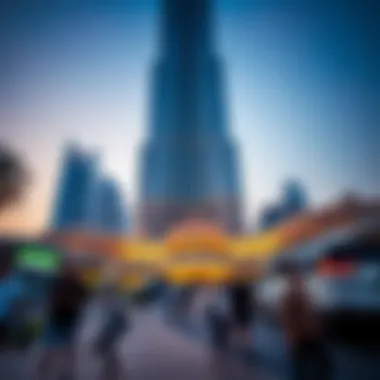

Sustainability and Future Developments
Sustainability has emerged as a crucial consideration in modern architecture, and Burj Khalifa serves as a leading example of this movement. The importance of sustainability in the context of Burj Khalifa goes beyond just its physical structure; it encompasses strategies that aim to minimize environmental impact while enhancing the quality of life for residents and visitors alike. Understanding these aspects is key for investors, homebuyers, and analysts, as sustainable practices often lead to better long-term returns on investments as well as higher property values.
As global awareness around climate issues grows, many real estate markets are leaning towards greener projects that resonate with environmentally conscious buyers. Thus, exploring the sustainable design principles of Burj Khalifa can provide insight into how high-profile projects can contribute to a more sustainable future.
Sustainable Design Principles
The design of Burj Khalifa incorporates a plethora of sustainable principles that prioritize energy efficiency. Some standout features include:
- Energy-efficient Systems: Burj Khalifa utilizes advanced technologies for heating and cooling, significantly reducing energy consumption compared to similar structures. For example, its double-glazed facade minimizes heat transfer, thus lowering reliance on air conditioning systems.
- Water Conservation: The building is equipped with water recycling systems that reuse greywater, thereby conserving a precious resource in the desert environment of Dubai. This not only is environmentally friendly but also reduces operational costs for property management.
- Smart Building Technologies: Integrated sensors and automated systems adjust lighting and climate controls based on occupancy, which leads to significant energy savings. This smart approach enhances the user experience while caring for the environment.
Each of these principles adds layers of value that are critical for prospective investors looking to align their portfolios with sustainable development goals.
Future Projects in Dubai Inspired by Burj Khalifa
The influence of Burj Khalifa extends beyond its towering height and luxurious amenities; it has sparked a wave of ambitious projects throughout Dubai. Many developers are now inspired to create structures that echo its sustainable ideology, setting a precedent for future developments. Here are a few notable examples:
- Dubai Creek Tower: Designed to become a focal point of the Dubai Creek Harbour, it aims to integrate smart technology and sustainability in its construction, reminiscent of the Burj Khalifa's approach.
- The Museum of the Future: Located in Dubai's financial district, this architectural marvel emphasizes green practices, including renewable energy sources and innovative waste management systems, making it a shining example of futuristic design with sustainability in mind.
- Dubai Urban Tech District: This development aims to create a hub focused on technology and sustainability, bringing together innovations that can shape the future of urban living, much like Burj Khalifa has done in defining Dubai's skyline.
"Sustainable design is not just a trend, but a necessity that reflects our responsibility towards future generations."
The present-day architectural landscape in Dubai is undoubtedly influenced by Burj Khalifa’s pioneering efforts, showcasing how such towering achievements can catalyze more sustainable practices in urban development. As attention shifts towards eco-friendly living, ongoing and upcoming projects will likely redefine how tall buildings are conceived, constructed, and experienced.
Cultural Significance of Burj Khalifa
The cultural significance of the Burj Khalifa transcends its physical stature as a building; it embodies the spirit, aspirations, and identity of Dubai and the UAE as a whole. In a city that has rapidly evolved from a small trading post to a global metropolis, this architectural marvel serves not just as a pinnacle of design but as a tangible representation of progress and modernity. As we explore its role, we see how it encapsulates elements of pride, national identity, and a cultural crossroads.
Symbol of National Identity
In the landscape of the UAE, Burj Khalifa has emerged as a lighthouse in the desert, a towering emblem of what the nation stands for. It symbolizes the ambition of a country that has set its sights on being a leader not only in the Arab world but also on a global stage.
- Pride and Achievement: For many Emiratis, the Burj Khalifa is a symbol of national pride. It reflects the achievements of their leaders and citizens who have worked collaboratively to turn a vision into reality. This sense of collection achievement is evident every New Year’s Eve, as the building becomes the focal point for national celebrations with its spectacular fireworks and light shows, drawing tourists and locals alike.
- Cultural Identity: The architectural design of the Burj Khalifa is traditional yet modern, echoing the rich heritage of Islamic art through its intricate patterns while incorporating cutting-edge technology. This juxtaposition invites a dialogue between past and present, engaging both locals and international visitors in an appreciation of the Emirati culture.
"When one sees Burj Khalifa, it’s not just a building; it’s our dreams and aspirations molded into concrete and glass."
Contributions to Arts and Events
The Burj Khalifa functions dually as a cultural hub and a canvas for artistic expression. It is home to a host of events and installments that enrich the cultural life in Dubai, highlighting its importance beyond mere tourism.
- Cultural Festivals: The tower is frequently the backdrop for various cultural festivals such as the Dubai Shopping Festival and the Dubai International Film Festival, showcasing local talent and promoting cultural diversity through art, cinema, and music.
- Art Installations: Burj Khalifa doesn’t shy away from modern expressions of art. Over the years, it has hosted a myriad of light projections that celebrate national milestones and global causes, effectively turning its face into a canvas for artistic dialogue. One notable example is the special tribute to healthcare workers globally, which saw the tower adorned with messages of gratitude and appreciation.
- International Collaborations: The building has not only provided a platform for local artistry but has also made room for international collaborations. Artists from around the globe have shared their work through dedicated events, fostering a spirit of camaraderie and exchange.
The Burj Khalifa is more than an architectural wonder; it is a vital component of the cultural fabric of Dubai and a fitting symbol of national pride. In both its physical form and cultural contributions, it draws people together, uniting them in celebration as well as in admiration for what has been achieved. Through these avenues, the structure not only contributes to the present but also shapes the future narrative of Dubai.
For further insights on the cultural impact of Burj Khalifa, please visit Wikipedia and Britannica.
Ending
The conclusion serves as the final capstone to our exploration of the Burj Khalifa, weaving together the threads of its architectural marvel, economic ramifications, and its enduring cultural legacy. Understanding the significance of this iconic edifice goes beyond mere statistics; it is about recognizing how a 828-meter tall structure can shift paradigms in urbanization and real estate dynamics. This article has unpacked how Burj Khalifa is not just a building; it is a national icon, an economic catalyst, and a beacon for innovation.
Summary of Key Points
To distill our findings:
- Architectural Feats: The Burj Khalifa stands as a crucial achievement in modern design, blending advanced construction techniques with symbolic aesthetics that reflect the essence of Dubai.
- Economic Influence: It’s pivotal in shaping Dubai’s real estate landscape, driving property values and attracting global investment.
- Cultural and Social Effects: As a tourist hub, Burj Khalifa cultivates a sense of national pride while serving as a venue for landmark events and cultural gatherings.
Moreover, the design's sustainability elements indicate a forward-thinking approach, suggesting that future projects can learn from its successes.
Future Outlook for Burj Khalifa and Dubai
The horizon looks promising for both the Burj Khalifa and the broader Dubai area. With ongoing developments, Dubai aims to bolster its standing as a global powerhouse for trade and tourism. Plans for adjacent projects might focus on integrating green spaces and smart city technologies that mirror the innovative spirit of Burj Khalifa. Investors should keep an eye on the evolving real estate landscape, blending luxury living with sustainability.
Specifically, the implications for property values remain an interesting point of discussion. As more developments blossom in the vicinity of this towering marvel, one can expect that the real estate market will continue to evolve dynamically, supported by both local and international buyer interest.
"A city's skyline is not just a reflection of its buildings; it’s a testament to its aspirations and dreams."
For more information, you can visit resources such as Wikipedia or Britannica.
Also consider articles on authentic perspectives from platforms like Reddit or local news shares from Dubai's government.



